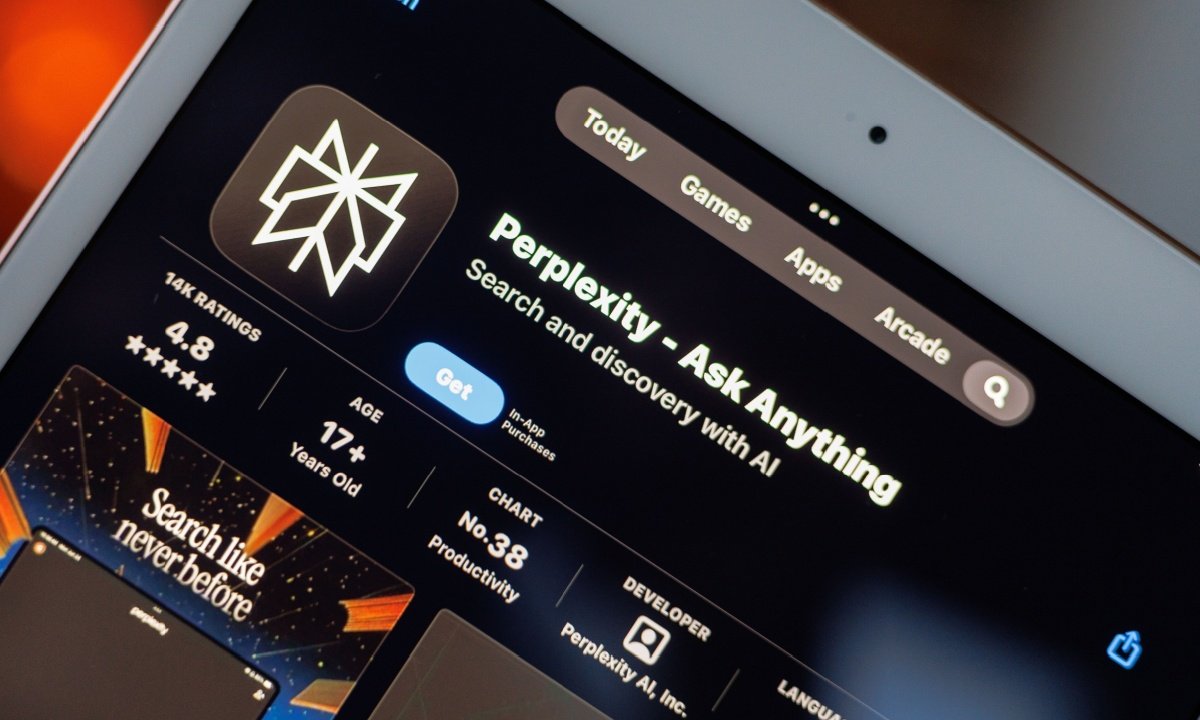AI Insights
Perplexity Wants to Add Its Comet AI Browser to Smartphones

AI Insights
Contributor: How do we prepare college students for the AI world?

The rise of artificial intelligence is threatening the foundations of education — how we teach, how we assess and even how students learn to think. Cheating has become effortless. Attention spans are dissolving. And the future job landscape is so uncertain that we don’t know what careers to prepare students for. A recent NBC News poll of nearly 20,000 Americans shows the public is evenly divided, with about half believing we should integrate AI into education and half believing we should ban it.
So, as we welcome the Class of 2029 to our campuses, what should colleges do?
Although some urge higher education to prioritize STEM fields and AI-related job skills, a surprising number of technology leaders are advising the opposite.
“I no longer think you should learn to code,” says investor and former Facebook executive Chamath Palihapitiya. “The engineer’s role will be supervisory, at best, within 18 months.”
Roman Vorel, chief information officer of Honeywell, argues that “the future belongs to leaders with high EQs — those with empathy, self-awareness and the ability to make genuine human connections — because AI will democratize IQ.”
Daniel Kokotajlo, co-author of “AI 2027,” which projects a set of scenarios leading to an “enormous” impact of superhuman AI over the next decade, puts it bluntly: “Economic productivity is just no longer the name of the game when it comes to raising kids. What still matters is that my kids are good people — and that they have wisdom and virtue.”
In other words, as machines gain in speed and capability, the most valuable human traits may not be technical but moral and interpersonal. Technology journalist Steven Levy spoke even more plainly in a recent commencement address at Temple University: “You have something that no computer can ever have. It’s a superpower, and every one of you has it in abundance: your humanity.”
It might seem like a tall order to cultivate attention, empathy, judgment and character — qualities that are hard to measure and even harder to mass-produce. Fortunately, we have an answer, one that turns out to be surprisingly ancient: liberal education. Small liberal arts colleges may enroll only a modest 4% of our undergraduates, but they are, historically and today, our nation’s seed bank for deep and broad humanistic education.
Liberal education is structured around serious engagement with texts, works of art and scientific discoveries that have shaped our understanding of truth, justice, beauty and the nature of the world. Students don’t just absorb information — they engage in dialogue and active inquiry, learning to grapple with foundational questions. What is the good life? What is the relationship between mathematics and reality? Can reason and faith coexist? Why do music and art move us?
These acts — reading, looking, listening, discussing — may sound modest, but they are powerful tools for developing the skills students most need. Wrestling with a challenging text over hours and days strengthens attention like physical exercise builds stamina. Conversation sharpens the ability to speak and listen with care, to weigh opposing views, to connect thought with feeling. This kind of education, by deepening our understanding of ourselves and our world, cultivates wisdom — and it’s remarkably resistant to the shortcuts AI offers.
If you spent a week at the college I lead, St. John’s College in Santa Fe, N.M., you might forget that AI even exists. It’s hard to fake a two-hour conversation about “Don Quixote” after reading only an AI summary, and it’s awkward to continue that conversation with your friends over a meal in the dining hall. Should you succumb to the temptations of AI in writing a paper, you’re likely to find yourself floundering in the follow-up discussion with faculty.
Liberal arts colleges have one other indispensable tool for deepening learning and human connection: culture. Most are small, tight-knit communities where students and faculty know one another and ideas are exchanged face to face. Students don’t choose these schools by default; they opt in, often for their distinctiveness. The pull of technology is less strong at these colleges, because they create intense, sustaining, unmediated experiences of communal thinking. This strong culture might be seen as a kind of technology itself — one designed not to dissipate minds and hearts, but to support and deepen them.
Paradoxically, four years largely removed from the influence of technology is one of the best ways of preparing for life and work in an increasingly technologized world.
Carla Echevarria, a 1996 alumna of St. John’s and now a senior manager of user experience at Google DeepMind, admits that she would “struggle with Schrödinger in senior lab and then bang my head against Hegel for a couple of hours and then weep in the library while listening to ‘Tristan und Isolde.’ That brings an intellectual fearlessness.
“When I started working in AI, I didn’t really know anything about AI,” she adds. “I prepared for my interview by reading for a couple of weeks. That fearlessness is the greatest gift of the education.” Many alums echo this belief regardless of the fields they go into.
As we head into this school year and into a future shaped by powerful and unpredictable machines, the best preparation may not be a new invention, but an old discipline. We don’t need a thousand new small colleges, but we need a thousand of our colleges and universities, large and small, to embrace an overdue renaissance of these deeply humanizing educational practices. We don’t need to outpace AI — we need to educate people who can think clearly, act wisely and live well with others.
J. Walter Sterling is the president of St. John’s College, with campuses in Annapolis, Md., and Santa Fe, N.M.
AI Insights
Artificial Intelligence (AI): powering law firm profitability

Profitability remains the ultimate benchmark of growth for law firms, yet sustaining it is no simple task. The most effective route to stronger profits lies in refining operational efficiency, delivering more, with greater accuracy, using the resources already available.
Forward-looking firms recognise that real change requires new ways of working. And the most accessible, cost-effective enabler of such change today is technology, specifically, Artificial Intelligence (AI).
AI as a catalyst for transformation
The rise of AI is ushering in a new era of productivity. By reshaping how legal professionals research, analyse, draft, and communicate, AI is transforming client service and redefining what lawyers can achieve. From predictive analytics to automated drafting, these tools accelerate legal processes and free up valuable lawyer time for strategic, high-value client interactions.
While cost is a natural concern, firms must consider the long-term return on investment. A well-planned AI strategy, underpinned by a cost-benefit analysis, will demonstrate significant efficiency gains and enhanced profitability.
Crucially, today’s advancements build on the foundations of integrated practice management systems. These platforms, housing vast stores of client and matter data, have paved the way for AI to thrive, enabling efficiencies unimaginable only a decade ago.
Optimising human potential
Staffing is one of the greatest expenses for any law firm. Compared with the ongoing costs of recruitment, training, and management, AI can prove to be a highly economical alternative. By automating low-value, routine work, such as research, data extraction, or document review, lawyers can concentrate on higher-value, client-facing activities.
This not only maximises return on investment but also provides opportunities for staff to upskill, focus on complex problem-solving, and deliver more meaningful contributions to clients. Importantly, AI should not be seen as replacing human expertise but as a complement that amplifies it.
Driving efficiency through data
Lawyers face countless time-consuming, repetitive tasks, yet the key to efficiency lies within the systems they use. Firms with modern, centralised practice management platforms are already positioned to take advantage of AI. When quality data is connected, AI tools can unlock unprecedented productivity, reduce errors, and streamline workflows.
Conversely, firms reliant on disconnected systems risk undermining AI’s effectiveness, missing out on the efficiencies and profit gains available to competitors.
Enabling sustainable innovation
Deploying AI independently can be expensive and risky without the right expertise. Partnerships with specialist legal technology providers, such as SOS Legal, offer law firms integrated AI solutions without prohibitive upfront investment. These tools drive operational efficiency, reduce overheads, and improve client service in a sustainable way.
Innovative applications such as AI-powered chatbots and virtual assistants are also changing the way firms engage with potential clients. By providing instant responses, guiding enquiries, and capturing data, these tools elevate lead generation while giving lawyers deeper insights into client needs.
The path forward
AI represents not a threat, but an opportunity. By embracing AI-driven technology, law firms can unlock new levels of efficiency, sharpen client service, and ultimately, enhance profitability. The firms that thrive will be those that use AI to complement human expertise, transforming their people into higher-value advisers while letting technology take care of the rest.
About SOS
SOS Legal’s next-generation software solution, SOS Innovate, is purpose-built to drive enterprise law firm growth and deliver continuous innovation.
With its cutting-edge, flexible architecture and modern design, SOS Innovate provides a scalable platform for ongoing technological advancement—empowering law firms to thrive in an ever-evolving legal landscape.
Designed specifically for enterprise law firms, SOS Innovate provides a powerful platform for the adoption of Legal AI tailored to the realities of modern legal practice. Streamlining research and accelerating drafting, Innovate is built to drive efficiency. For more information book a demo of SOS Innovate here.
This article was submitted to be published by SOS as part of their advertising agreement with Today’s Wills and Probate. The views expressed in this article are those of the submitter and not those of Today’s Wills and Probate
AI Insights
Better Artificial Intelligence Stock: ASML vs. Taiwan Semiconductor

ASML and Taiwan Semiconductor are foundational AI companies, but only one is delivering impressive results for shareholders.
The artificial intelligence (AI) boom has been fueled by large tech companies developing impressive AI models that can handle increasingly complex tasks. But a sometimes overlooked aspect of AI are the companies that manufacture complex processors that make those models possible.
Two such semiconductor manufacturing companies are ASML (ASML -2.78%) and Taiwan Semiconductor Manufacturing (TSM -3.05%), often referred to as TSMC. While both have their strengths, which one looks like the better stock right now? Here’s what’s happening with each, and which one is likely the better AI stock.
Image source: Getty Images.
ASML’s opportunities and risks
ASML has a unique angle in the processor manufacturing market through its extreme ultraviolet (EUV) lithography system that’s used to make AI processors. These machines are very complex and not easily replicated, which is why ASML is one of the few companies in the world with these machines. This means that any semiconductor manufacturing company that needs one of these machines has to come to ASML for it.
Despite this opportunity, it’s not all sunshine and rainbows for ASML’s business. The company is reeling from President Donald Trump’s tariffs, and management said recently that potential growth in 2026 will be affected by them. ASML CEO Christophe Fouquet said on the Q2 earnings call: “We continue to see increasing uncertainty driven by macroeconomic and geopolitical developments. Therefore, while we still prepare for growth in 2026, we cannot confirm it at this stage.”
That’s a shift from management’s previous stance that the company would grow significantly this year and next. The company also lowered its estimated sales for this year to about 32.5 billion euros, down from its previous estimate of up to 35 billion euros.
That uncertainty has caused ASML’s shares to plunge recently, dropping 13% over the past 12 months. And with investors still unsure how tariffs will impact the company over the next couple of years, they’re right to be a little wary.
TSMC’s advantages and challenges
Taiwan Semiconductor also has a unique position in the AI space. The company is the leading manufacturer of AI processors, with an estimated 90% of the advanced processor market. This means that when AI giants, including Nvidia, need AI processors made, Taiwan Semiconductor is often their first choice.
This demand continues to fuel growth for the company, and TSMC’s management estimates that AI sales will double this year. The company is already well on its way, with revenue rising by 38% to $30 billion in Q2. TSMC’s bottom line is impressive as well, with earnings rising 61% to $2.47 per American depository receipt (ADR).
And while ASML is experiencing some turbulence with its business, TSMC is still going strong. Taiwan Semiconductor CEO Wendell Huang said, “Moving into third quarter 2025, we expect our business to be supported by strong demand for our leading-edge process technologies.”
Continued demand for AI processors has resulted in TSMC’s share price climbing about 40% over the past 12 months, which is significantly better than the S&P 500‘s gains of 15% over the same time. While some investors are concerned about when the AI boom will be over, it’s certainly too early to call it now.
The verdict: Taiwan Semiconductor is the better AI stock
Taiwan Semiconductor is increasing sales and earnings at a healthy clip, has a corner on AI processor manufacturing, and continues to benefit from an expanding AI market. While ASML is a strong contender, the company’s recent tariff uncertainty and lowered sales expectations aren’t great news for investors.
ASML stock is also slightly more expensive than TSMC’s at the moment, with a price-to-earnings (P/E) ratio of about 28, compared to Taiwan Semiconductor’s 26. I think both companies could be good long-term AI investments, but for all the reasons above, I think Taiwan Semiconductor deserves the win in this matchup.
Chris Neiger has no position in any of the stocks mentioned. The Motley Fool has positions in and recommends ASML, Nvidia, and Taiwan Semiconductor Manufacturing. The Motley Fool has a disclosure policy.
-

 Business3 days ago
Business3 days agoThe Guardian view on Trump and the Fed: independence is no substitute for accountability | Editorial
-
Tools & Platforms3 weeks ago
Building Trust in Military AI Starts with Opening the Black Box – War on the Rocks
-

 Ethics & Policy1 month ago
Ethics & Policy1 month agoSDAIA Supports Saudi Arabia’s Leadership in Shaping Global AI Ethics, Policy, and Research – وكالة الأنباء السعودية
-

 Events & Conferences3 months ago
Events & Conferences3 months agoJourney to 1000 models: Scaling Instagram’s recommendation system
-

 Jobs & Careers2 months ago
Jobs & Careers2 months agoMumbai-based Perplexity Alternative Has 60k+ Users Without Funding
-

 Funding & Business2 months ago
Funding & Business2 months agoKayak and Expedia race to build AI travel agents that turn social posts into itineraries
-

 Education2 months ago
Education2 months agoVEX Robotics launches AI-powered classroom robotics system
-

 Podcasts & Talks2 months ago
Podcasts & Talks2 months agoHappy 4th of July! 🎆 Made with Veo 3 in Gemini
-

 Podcasts & Talks2 months ago
Podcasts & Talks2 months agoOpenAI 🤝 @teamganassi
-

 Mergers & Acquisitions2 months ago
Mergers & Acquisitions2 months agoDonald Trump suggests US government review subsidies to Elon Musk’s companies





















